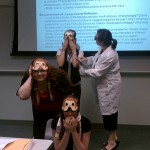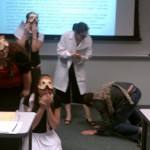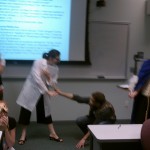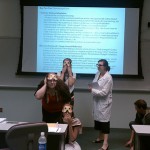Well, I was really glad I handed out copies of my PowerPoint because I really didn’t explain my lesson the way I was planning. I had more to say about the unit and my full-circle learning objectives and I am not sure they came across as well as I wanted, but that’s the way presentations play. Overall, I learned a lot about how I would actually present and teach these activities. Ya’ll were a great class to start with and I appreciate your comments.
Why did I have graduate students dress up in costumes? Because I do not have high school students to dress up in costumes. Seriously, this was my only chance to see how the Ivanhoe Tableau would work out, how long it would take, if the costumes would lead to the discussion topics I was hoping for, or if it would fall flat. The costumes were also a way to force engagement with the activity and help with the on-the-spot thinking of the activity. So a huge thanks to everyone who participated!
As I mentioned during my presentation, after seeing the limitations of the tableau I would definitely opt for a full Ivanhoe and have students re-act the scene with the new characters. I was just so bent on ‘teaching’ the three new reading tools that I couldn’t get the concept of the tableau out of my head. I really wanted to share these three reading tools which help me in my own reading process. We can never have enough tools to hand over to our students and I hope you found them interesting if not useful. However, the in-class comments on the impact of the additional characters (the non-literary monkey and Shakespeare) make the dramatic Ivanhoe a success. I wish there had been time to try the Question Relay before the Ivanhoe to see if this layering of activities produced different reflections. I was also pushing the Hamlet connection, but as we never had previous Hamlet discussions it was hard to frame this connectivity. I was aiming for a better discussion of how performance inquiries lead back to deeper textual interpretation especially when dealing with texts of meta-theatre, like Hamlet.
Any comments are really appreciated. I am curious about your take on the screenplay assignment and whether a Question Relay Follow-Up hand out would actually allow me less direct involvement in structuring a discussion or if I am kidding myself. Thank you again for playing along and allowing me the rare opportunity to teach a class.




Your presentation was entertaining and hilarious! I learned more about plays than I had known (blocking and beats). I think students would love the Ivanhoe activity, and you could even integrate both acting out the scene and freezing for a tableau. It’s a great way to get students involved and to really think about the characters.
Your questions about why Dr. Rosenbaum was written off-stage?, what was it like as an audience member to watch the tableaus?, etc. were great leading questions to have the students think about the relationship between author and audience. Also, I like the “question flood” idea that Nikki first introduced, and I would certainly steal that for lessons.
I think most students would be enthusiastic about writing a screenplay, but maybe you could give students a choice too. Perhaps, you could have the creative assignment of writing a screenplay and a more analytic assignment of having students write a review of a screenplay. Great job!
Even as an ex-theater geek, I didn’t know this stuff about beats and tableaus…not really. When you started, I was racing a little to keep up with you. I think that, especially for total newbies, it would be great to have a day before this one where you explained these concepts and gave lots of examples, or did micro-lessons on each of them. It would make your activity even more effective.
The lesson, itself, was really fun. I can see high school students really losing track of time and getting involved in the hilarity. It’s the type of activity that all teachers are seeking in order to keep stuff fresh and get the students to pay attention. With your expertise in drama, you could really bring life to the English classroom.
I wish I’d played Shakespeare differently! But even that is fodder for discussion. Loved it.
I agree that the active participation did a lot to get us all into the lesson. As a participant, I had some interesting realizations that I wrote about during the reflection time: When reading the play, I of course pictured it in my head, but I think I pictured it as tableaus (I can use that word now that I know its meaning!) — I didn’t mentally register the smaller movements. When acting out the section you chose, I realized how much movement and interaction there really was between the characters. Maybe this seems like a “well, duh” reaction about reading drama vs. seeing/performing drama, but it did a lot to bring the play more alive for me, and I think it would do the same for your students (esp. HSers).
I agree with Alicia that a day before the activity could be used to introduce the concepts, explain the terms, and get students familiar with everything before moving into the activity the next day. I know you had a lot you wanted to get through, and I’m sure you would slow it down when actually teaching it “live” in classroom 🙂
Overall, well done. I’m glad someone in the class chose to teach drama! It was a nice switch from poetry and stories.
Faye,
Loved your presentation!! I think the more we can get students moving around and having fun with a text, the more they are likely to remember it/be engaged with it. Costumes are always a plus, and I really LOVED how you used the concept of constumes to tie back into the idea of masks in Hamlet. Awesome idea.
Thank you for giving me a glimpse into the jargon of theater–the beats, tableaus, blocking, etc. I agree with others that it would be good to introduce those concepts the day before the activity so students can think about them and come to the activity with a clear understanding of the terms. The whole time I was thinking about how tableaus are kind of like Blau’s “most important line” concept (I think you may have mentioned that?). I wish we had more time to look at all the tableaus and talk more in depth about how they changed our understanding of the play. Regardless, I’m always a fan of Ivanhoe and overall it was a great activity. I think this play would be perfect to incorporate into a Hamlet discussion for a more “fun” lesson.
You are so positive and so creative! You’re going to be an awesome teacher!
Faye, you rocked! Hope that you were able to help Alison in Terry’s class for her Gatsby unit.
I think most people have already covered what I have to say: namely, GREAT choice of text (I was literally laughing out loud while reading it) and excellent interactive lesson activities! The costumes/acting out elements really encouraged student participation and engagement. A kid would have to be pretty aloof not to be at least somewhat interested in what was going on in that lesson.
I also really liked that the play you chose went along with Hamlet. I can see lots of possibilities for how to link the two together (esp. considering the play in the play aspect of Hamlet, guises, masks, etc.) and I think having them write their own screenplay would be a great way to tie things together at the end. I can also see how you could teach Words, Words, Words without necessarily tying it to Hamlet (in a drama class even). It’s definitely a versatile play!
And again, thanks for introducing us to something so smart and funny! I want to check out more of his work now!